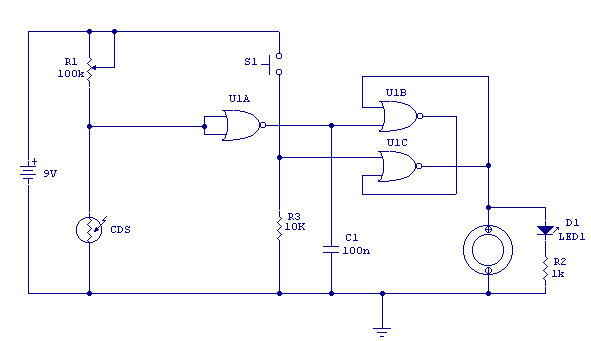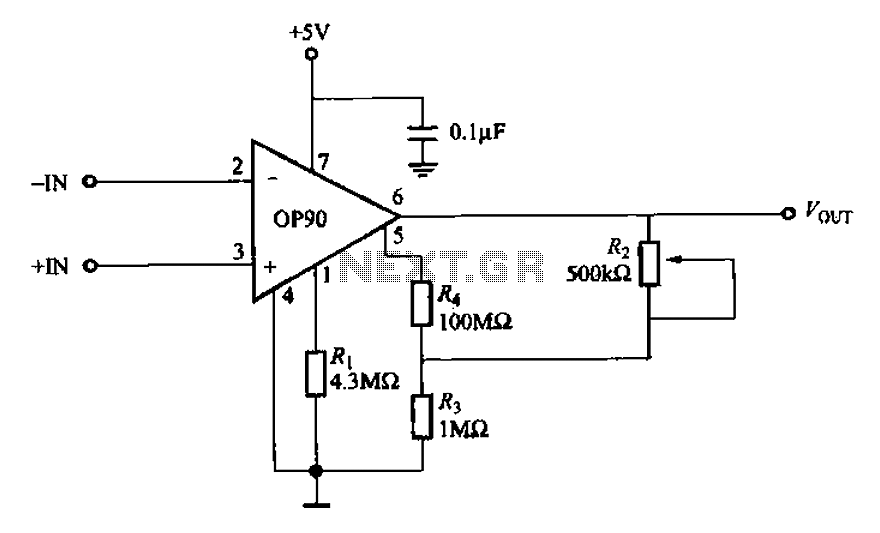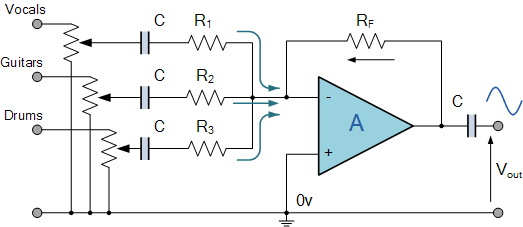
static detector negative ion detector

A sensitive detector for static electricity is based on a single Field Effect Transistor (FET). It can also be utilized to detect the presence of negative ions or to test a negative ion generator. This circuit takes advantage of the extremely high input impedance of a FET and demonstrates the sensitivity of the gate terminal to voltage changes. The gate terminal is left open circuit, connected solely to the "probe," which consists of a few inches of bare copper wire. Without fixed DC biasing, the gate terminal responds to minute voltage changes, causing a current variation in the drain circuit that the meter indicates as a charge or "field strength." It is crucial not to construct this circuit on veroboard or PCB material, as this would reduce the effective gate impedance. Instead, an "open" construction technique is recommended, with each component soldered together. The probe should not be touched directly and is best insulated within a plastic pen sleeve. Since static electricity can carry either a positive or negative charge, the meter used should be a center-zero type. Full-scale deflection can be set to 1 mA or 250 µA for increased sensitivity. To calibrate, remove the meter and use a multimeter to measure the voltage between the FET drain and the preset resistor, adjusting the preset for 0 volts before replacing the meter to avoid "bending" the needle. When placed in a room, the meter will detect changes in static charge, with positive charge deflecting the needle in one direction and negative charge in the opposite. The circuit can be tested by positioning the unit approximately 5 feet away from a television set. Upon activation, the meter needle should initially jump to full-scale deflection before dropping back down. If a room ionizer is present, its output can be monitored by moving the probe in front of it. As the detector responds to variations in charge, repositioning may be necessary to observe the effect, confirming that the air ionizer is functioning.
The static electricity detector circuit primarily consists of a single Field Effect Transistor (FET), which serves as the sensitive element for detecting electric fields. The design emphasizes the high input impedance characteristic of FETs, allowing it to detect minute changes in voltage induced by static electricity or negative ions. The probe, made from a short length of bare copper wire, is critical for sensing electric fields; it is connected directly to the gate terminal of the FET, which remains open-circuit to maximize sensitivity.
Construction of the circuit should follow an open layout rather than being mounted on a veroboard or PCB. This is essential because traditional circuit boards can introduce parasitic capacitance, effectively lowering the input impedance and compromising the detector's performance. Components should be soldered directly together with minimal distance between them to maintain high sensitivity.
The meter used for output readings should be a center-zero type to accommodate both positive and negative charges. The choice of 1 mA or 250 µA for full-scale deflection allows for flexibility depending on the application and desired sensitivity. Calibration involves using a multimeter to set the voltage at the FET drain to zero before replacing the meter, ensuring accurate readings without mechanical stress on the meter's needle.
In practical applications, the detector can be used to monitor environmental static charges or the output of ionizers. The response of the circuit to nearby electronic devices, such as televisions, can be tested to evaluate its effectiveness. The detector's ability to indicate changes in charge makes it a valuable tool for assessing electrostatic conditions in various settings, including laboratories and clean rooms.A sensitive detector for static electricity based around a single Field Effect Transistor It can also be used to detect the presence of negative ions, or test a negative ion generator. This circuit utilizes the extra high input impedance of a FET, and also demonstrates the gate terminals sensitivity to changes in voltage.
The gate terminal here is left open circuit, connected only to the "probe". The probe is just a few inches of bare copper wire. With no fixed DC biasing, the gate terminal will respond to micro changes in voltage. This causes a current change in the drain circuit and the meter will indicate a charge or "field strength". It is important not to make this circuit on veroboard or PCB material as this will reduce the effective gate impedance.
Instead use an "open" construction technique soldering each component together. The probe should not be touched directly and is best insulated in a plastic pen sleeve. As static electricity can have either a positive or negative charge, the meter used should be a centre zero type. Full scale deflection can be 1mA or 250uA for greater sensitivity. Remove the meter and use a multimeter to measure the voltage between FET drain and the preset resistor.
Adjust the preset for 0 volts and then replace the meter. This will avoid "bending" the needle. If placed in a room the meter will detect changes in static charge, positive charge deflecting the needle one way and negative the other way. You can test the circuit by placing the unit say 5 feet away from a TV set. When switched on, the meter needle should jump to full scale deflection and then drop down again. If you have a room ionizer, its output can be monitored by moving the probe in front of it. As the detector responds to changes in charge, you may need to move the detector around to see the effect, but it will prove the output from an air ionizer is working.
🔗 External reference
The static electricity detector circuit primarily consists of a single Field Effect Transistor (FET), which serves as the sensitive element for detecting electric fields. The design emphasizes the high input impedance characteristic of FETs, allowing it to detect minute changes in voltage induced by static electricity or negative ions. The probe, made from a short length of bare copper wire, is critical for sensing electric fields; it is connected directly to the gate terminal of the FET, which remains open-circuit to maximize sensitivity.
Construction of the circuit should follow an open layout rather than being mounted on a veroboard or PCB. This is essential because traditional circuit boards can introduce parasitic capacitance, effectively lowering the input impedance and compromising the detector's performance. Components should be soldered directly together with minimal distance between them to maintain high sensitivity.
The meter used for output readings should be a center-zero type to accommodate both positive and negative charges. The choice of 1 mA or 250 µA for full-scale deflection allows for flexibility depending on the application and desired sensitivity. Calibration involves using a multimeter to set the voltage at the FET drain to zero before replacing the meter, ensuring accurate readings without mechanical stress on the meter's needle.
In practical applications, the detector can be used to monitor environmental static charges or the output of ionizers. The response of the circuit to nearby electronic devices, such as televisions, can be tested to evaluate its effectiveness. The detector's ability to indicate changes in charge makes it a valuable tool for assessing electrostatic conditions in various settings, including laboratories and clean rooms.A sensitive detector for static electricity based around a single Field Effect Transistor It can also be used to detect the presence of negative ions, or test a negative ion generator. This circuit utilizes the extra high input impedance of a FET, and also demonstrates the gate terminals sensitivity to changes in voltage.
The gate terminal here is left open circuit, connected only to the "probe". The probe is just a few inches of bare copper wire. With no fixed DC biasing, the gate terminal will respond to micro changes in voltage. This causes a current change in the drain circuit and the meter will indicate a charge or "field strength". It is important not to make this circuit on veroboard or PCB material as this will reduce the effective gate impedance.
Instead use an "open" construction technique soldering each component together. The probe should not be touched directly and is best insulated in a plastic pen sleeve. As static electricity can have either a positive or negative charge, the meter used should be a centre zero type. Full scale deflection can be 1mA or 250uA for greater sensitivity. Remove the meter and use a multimeter to measure the voltage between FET drain and the preset resistor.
Adjust the preset for 0 volts and then replace the meter. This will avoid "bending" the needle. If placed in a room the meter will detect changes in static charge, positive charge deflecting the needle one way and negative the other way. You can test the circuit by placing the unit say 5 feet away from a TV set. When switched on, the meter needle should jump to full scale deflection and then drop down again. If you have a room ionizer, its output can be monitored by moving the probe in front of it. As the detector responds to changes in charge, you may need to move the detector around to see the effect, but it will prove the output from an air ionizer is working.
🔗 External reference





